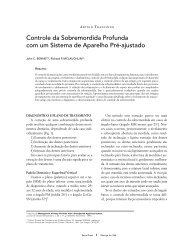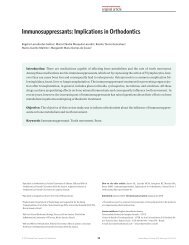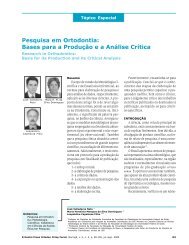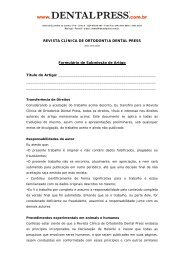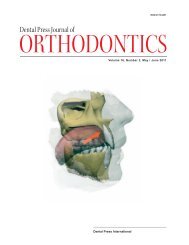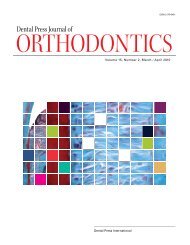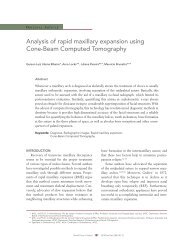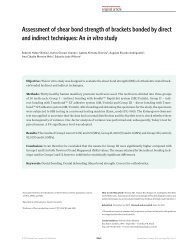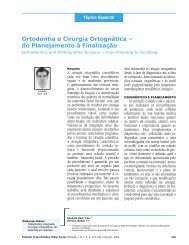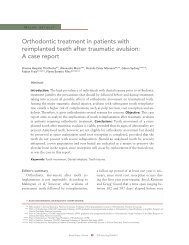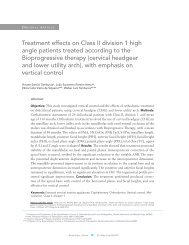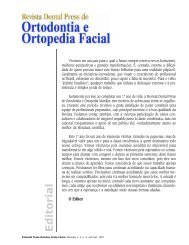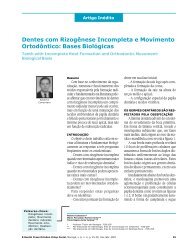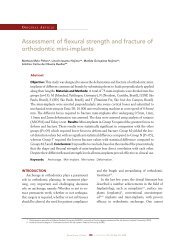Dental Press
Dental Press
Dental Press
Create successful ePaper yourself
Turn your PDF publications into a flip-book with our unique Google optimized e-Paper software.
[ original article ] In vitro evaluation of shape changes in curved artificial root canals prepared with two rotary systemsIntroductionThe main goal of preparing root canals is to providecleanliness and shape, resulting in a surgically preparedcanal with tapered shape, seeking to preserve its originalanatomy. 1 This task is considerably difficult to beachieved in curved and narrow root canals, because thestainless steel files tend to straighten the canal curvature,causing aberrations which were described by Weineet al, 2 as zip, elbow and danger zones.The nickel-titanium (NiTi) rotary systems were designedto prepare root canals with marked curvatures.The ProDesign (Easy ® , Belo Horizonte, Brazil) systemis composed of rigid preparation files with high-cuttingefficiency to work in the straight part of the canal (0.7 taper#20 and 0.10 taper #35). The apical files have triplehelix and good flexibility (0.3 taper #20, 0.5 taper #15,0.4 taper #22, 0.4 taper #25 and 0.6 taper #20).ProTaper instruments (Dentsply Maillefer ® , Ballaigues,Switzerland) present innovative files concerningtaper variation (multitaper) of 3.5% to 19%. The techniquewhich is used for the system is the crow-downtechnique, and the system has three root canal shapingfiles (shaping SX, S1 and S2), of greater taper, and threeapical preparation files (finishing files) with different diameters:#20 (F1), #25 (F2) and #30 (F3). 3 Recently,Dentsply Maillefer ® (Ballaigues, Switzerland) mademodifications to the system and named it ProTaperUniversal. 4 Therefore, it was the goal of this study toassess the shape modifications of the simulated curvedcanals after using ProTaper Universal, ProDesign anda hybrid technique combining both rotary systems, aswell as the final mean shape for each case was also assessed.Materials and MethodsA total of 75 Endo-training resin blocks (DentsplyMaillefer ® , Ballaigues, Switzerland) with gradual curvaturesof about 40 degrees, according to the Schneider 5method were used in this study.Working lengthIn order to establish the working length (WL), a K-File #10 (Dentsply Maillefer ® , Ballaigues, Switzerland)was placed up to the apical end of each simulated rootcanal to determine patency (P). This was establishedby using the transparency of the resin blocks. For instrumentationsequence, 1 mm of this measure was reducedto determine the WL.Photographic ProceduresA total of two references were determined in theresin blocks for image superimposed before and afterthe preparation of the simulated root canals. India ink(Acrilex ® ) was inserted in the artificial root canals inorder to photograph them before and after preparation.The blocks were placed always in the same position,and photographed using a Nikon D7OS camerawith 60 mm macro lenses, 0,23 focal length, underfluorescent lighting attached to an LPL light stand,following the same subject-to-camera distance. In orderto quantify the transportations produced by theinstruments, a measured section was placed alongwith the resin blocks. After preparation, the blockswere photographed one more time, using the initialposition direction and the previously establishedsubject-to-camera distances. The photos were digitalizedand edited using (Photoshop 6.0; Adobe, San,Jose) and superimposed in order to analyze possiblemodifications.Preparation of simulated root canalsThe 75 blocks were randomly divided into fivegroups with 15 samples each and handled by a singleoperator, who had previous experience performingboth systems. Gates-Glidden drills (Dentsply Maillefer® , Ballaigues, Switzerland) #5, #4, #3, #2, and #1were used for all groups in the straight segment of theroot canal. Endo Easy SI (Easy ® , Belo Horizonte, Brazil)electric engine, started the files of both systems.For Protaper Universal Sx, S1, S2 and F3 instrumentsa speed of 300 rpm and a 3 N.cm torque were applied.Protaper Universal instruments F1 and F2 required300 rpm speed and 2 N.cm torque. For ProDesignfiles a chip inside the device was responsible forprogramming files sequence, speed and torque. Ateach instrument change canals were abundantly irrigatedwith 2 ml of distilled water (Pharmakon ® Uberaba,Brazil), along with 0.25 ml of bi-distilled glycerin(Farmax ® , Brazil), in order to lubricate the canal andmake the instrumentation easier in each block. A #10instrument was taken up to the patency to preventresin residues from accumulating. The blocks with artificialroot canals were fixed into a mini vice (Western® ) for easier handling. A dark-colored adhesivetape was placed to cover the preparation, simulatingthe clinical condition.© 2011 <strong>Dental</strong> <strong>Press</strong> Endodontics 70<strong>Dental</strong> <strong>Press</strong> Endod. 2011 apr-june;1(1):69-76



